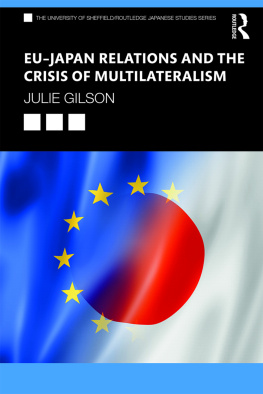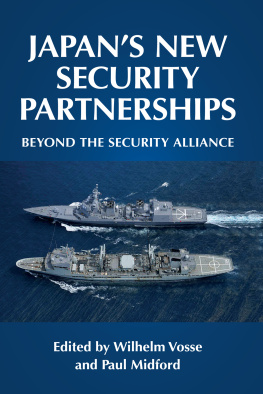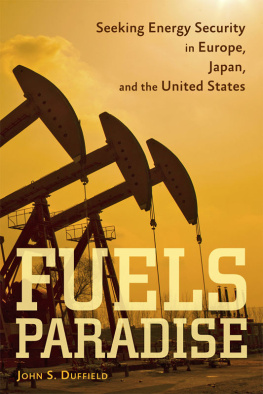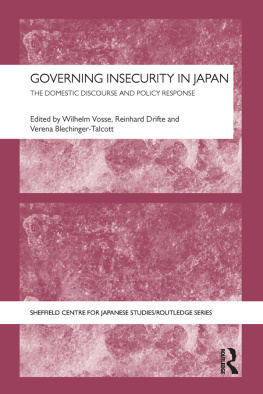
The US-Japan Security Community
Drawing on the work of Karl W. Deutsch, this book argues that the United States and Japan have formed their own security community, based on a sense of collective identity. In so doing, it provides a new theoretical outlook on co-operation between the United States and Japan, offering a fresh understanding of their bilateral relationship as one that goes beyond a mere military alliance or free trade partnership.
Taking an empirical approach, Sakai analyzes three key case studies: the Persian Gulf War of 19901, the terrorist attacks of September 11, 2001, and the Tohoku Earthquake and Tsunami of 2011. He examines how the United States and Japan interacted with one another in their discourses and behaviors in these three instances and thus demonstrates the existence of a collective identity between the two nations.
Hidekazu Sakai is Associate Professor of Kansai Gaidai University, Japan. His research interests include international relations theory, international security, peacebuilding, and Asian-Pacific politics. His recent publications include Re-rising Japan: Its Strategic Power in International Relations (2017), co-edited with Yoichiro Sato.
Routledge Studies on the Asia-Pacific Region
Local Political Participation in Japan
A Case Study of Oita
Dani Daigle Kida
The US-Japan Security Community
Theoretical Understanding of Transpacific Relationships
Hidekazu Sakai
For more information about this series, please visit: www.routledge.com/Routledge-Studies-on-the-Asia-Pacific-Region/book-series/RSAPR
The US-Japan Security Community
Theoretical Understanding of Transpacific Relationships
Hidekazu Sakai
First published 2019
by Routledge
2 Park Square, Milton Park, Abingdon, Oxon OX14 4RN
and by Routledge
711 Third Avenue, New York, NY 10017
Routledge is an imprint of the Taylor & Francis Group, an informa business
2019 Hidekazu Sakai
The right of Hidekazu Sakai to be identified as author of this work has been asserted by him in accordance with sections 77 and 78 of the Copyright, Designs and Patents Act 1988.
All rights reserved. No part of this book may be reprinted or reproduced or utilised in any form or by any electronic, mechanical, or other means, now known or hereafter invented, including photocopying and recording, or in any information storage or retrieval system, without permission in writing from the publishers.
Trademark notice: Product or corporate names may be trademarks or registered trademarks, and are used only for identification and explanation without intent to infringe.
British Library Cataloguing-in-Publication Data
A catalogue record for this book is available from the British Library
Library of Congress Cataloging-in-Publication Data
A catalog record has been requested for this book
ISBN: 978-1-138-48667-6 (hbk)
ISBN: 978-1-351-04491-2 (ebk)
Typeset in Times New Roman
by Out of House Publishing
To my wife, Kyoko.
Contents
It was impossible to complete this book without inspiration, help, advice, and encouragement from a number of people. The root of this book is my masters thesis, The New Roles and Characteristics of the United States-Japanese Security Alliance in the Post-Cold War Era, which I submitted to Department of Political Science of California State University, Fresno in 1993, although its scope is completely different from this book. From time to time during all these years, I presented previous versions of this books chapters at meetings of Asian Studies on the Pacific Coast (ASPAC) in Honolulu (2007); the International Studies Association (ISA) in New York (2009), New Orleans (2010, 2015), and its international confernce in Hong Kong (2017); the International Convention of Asian Scholars (ICAS) in Adelaide, Australia (2015); and the Asia Pacific Conference of Ritsumeikan Asia-Pacific University (APU) in Beppu, Japan (2015). I am indebted to many comments and much feedback from panel participants and audiences; it is impossible to list all of their names here. Nevertheless, I offer my sincerest gratitude to them for sharpening my thoughts on the security community. Due to limited space, I only can list a handful of people here.
I am grateful to Dr. Russell Mardon, Dr. Marn J. Cha, and Dr. Freemen Wright (deceased), who taught me the foundations of international relations (IR) at California State University, Fresno between 1990 and 1993. I give my appreciation to Dr. Shinobu Yamazaki for his continual friendship since our graduate studies in Fresno in the early 1990s.
I would like to offer special thanks to Dr. Glenn D. Paige (deceased), who taught me nonviolent politics, and its innovative potentiality for IR. His limitless passion for nonkilling global political science took me toward studying the security community. I am grateful to his wife Glenda Paige, who has shared his passion toward a nonkilling global society. I am thankful to Dr. Lou Ann H. Guanson (former Director of the Matsunaga Institute for Peace at the University of Hawaii). I thank Dr. Michael Haas, Dr. Yasumasa Kuroda, Dr. Leslie Sponsel, and Dr. James A. Dator for their magnificent insight on peace studies. I thank Johan Galtung (former Professor of Peace Studies at the University of Hawaii), who taught me the importance of creative thinking on peace. I thank Dr. Ralph Summy for his significant insight on nonviolent political alternatives during his directorship of the Matsunaga Institute for Peace at the University of Hawaii. I thank Mr. Yoshihisa Fujita and Ms. Shizuko Fujita for their untold support and encouragement. I thank Dr. S. P. Udayakumar, Ms. Meera Udyakumar, and Dr. Naruo Yoshikawa for their friendship. I thank Dr. Yukio Tsuda (Professor Emeritus of Tsukuba University), Ms. Mona Ohya, Dr. Minoru Koide (Soka University), Dr. Jay Heffron (Soka University of America), and Mr. Arnold Kawasaki (Soka University of America) for their warm support. I am grateful to Dr. In-Young Kim for unchanged friendship since the days of graduate study at the University of Hawaii at Manoa.
I am sincerely grateful to the Toda Peace Institute (formerly called the Toda Institute for Global Peace and Policy Studies), which granted me a pre-doctoral fellowship (as the first recipient of the Institute) in 1996, and allowed me to participate in its several workshops and conferences elsewhere. I thank Dr. Majida Teheranian (the first Director of the Toda Institute for Peace and former Professor of Communication at the University of Hawaii; deceased). I thank Mr. Tomosaburo Hirano (former Deputy Director of the Toda Institute for Peace; deceased) who taught me the importance of accumulating academic efforts in ones 40s, which will be rewarded in ones 50s. I also thank Dr. Satoko Takahashi (former Deputy Director and Program Manager of the Toda Institute for Peace) for her encouragement. I thank Dr. Olivier Urbain (the second Director of the Toda Institute for Peace), Dr. Kevin Clements (current Director of the Toda Institute for Peace), and Ria Shibata for their friendship.
Special thanks go to my colleagues at Kansai Gaidai University: Dr. Jeff Hester, Dr. Steven Fedorowicsz, Dr. Kazuhiko Nakae, Dr. Tomohiro Uchida, prof. Zoe Jenkins, prof. Peter Edwards, prof. Dawn Booth, and Dr. Maiko Ichihara (currently at Hitotsubashi University), who always cheer me up. I learned many sociological insights on US-Japan relations from Dr. Takeshi Matsuda. I am grateful to Dr. Mark Holstein, with whom I started my doctoral program at the Department of Political Science of the University of Hawaii at Manoa in 1993; amazingly, he has now been my colleague at Kansai Gaidai University for 15 years.










